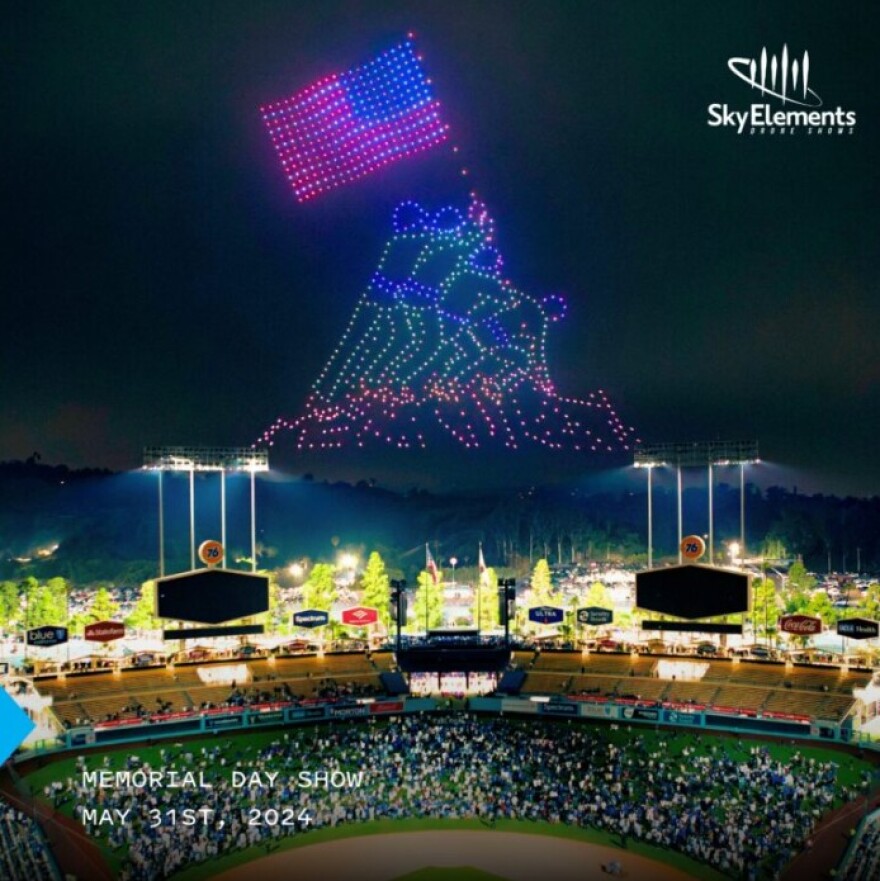
Historians agree that pyrotechnics, aka fireworks, were first created in ancient China. In the modern age, while it’s still tradition to illuminate the night sky with colorful explosives on certain holidays and other special events, there’s a new kid in town: The drone show.
Throughout July, the City of St. Petersburg has been celebrating the 5th anniversary of the “new” St. Pete Pier. This Sunday, July 27, 4 to 10 p.m. bring a community technology demo festival, including cutting-edge technology from robotics and VR to AI and smart city tools.
The Pier drone show begins at 9 p.m. The Catalyst spoke with Preston Ward, Chief Pilot for Texas-based Sky Elements, which is producing the St. Pete Event. One of the most experienced drone light show pilots in the world, he’s also the company’s general council, able to leap stacks of red tape in a single bound and work with the Federal Aviation Administration on rules and safety procedures (drones, after all, are tiny aircraft).
“The thing that’s really hard for people to understand, until they see a drone show in person, is the scale,” Ward said. “These images are huge, and if you see one on TV, or the internet, you don’t have any reference point – you’re just looking at the sky going ‘OK, that’s nice.’ But in person you can see how big these images are. It’s really, really massive.”
How massive? The synchronized drones can “paint” a picture 500 feet in diameter, 400 feet off the ground.
How does it work?
The animation team works with the client (in this case, the St. Pete Pier) to design images that will resonate with the local audience (look from each of the earlier piers, for example). Every Sky Elements show is customized for its project.
There will be 1,000 battery-powered drones at the Pier show. They are identical, weighing 2 and ½ pounds each, and are durable enough to withstand wind and rain (to a certain extent).
The drones are laid out about one meter apart and their takeoffs are staggered. In the air, they are never closer than two meters (approximately six feet) from one another.

“Unlike normal camera drones, these drones have a very sophisticated GPS,” Ward said. “So we sent a GPS signal to them that keeps them very, very accurate, to within one centimeter. That’s why they stay so precise, and how we keep them from hitting each other.”
On the ground, there are two pilots at two computers – a primary, and a backup. “And we have that second human there – a layer of redundancy – making sure that everything on that checklist is getting done, as well as an extra set of eyes.”
None of the drones will return to earth until the show has concluded (about 15 minutes). At the conclusion of each image, the drone lights go off, and the transition begins to the next image in the program. After the show, they’re programmed to land and shut down.

‘Those extra moments’
Ward is particularly pleased that 25 St. Pete flying machines are “pyro drones,” equipped with good old-fashioned light-em-up fireworks. This was pioneered by Sky Elements. “It took me 2 ½ years to get the FAA to give us the first-ever approval last year, so it’s still new,” he explained. “And it’s something super-unique.”

Even though there’s a stirring music track blaring during the show, for some people it’s all about that boom from the exploding rockets.
This takes some extra planning, Ward said. “Once the animation team has programmed the images you’re going to see in the sky, from there, we’ll take that animation and we’ll decide ‘Where are we going to place those pyrotechnics?’ Those extra moments.
“We’ll work with the animation team to determine the best spots. We might have to re-design certain elements of the show, to make sure we have safety distances. Then we have to program the pyrotechnics system to make sure that the timing’s all correct and matched up.”
Pyrotechnics can also lend some oomph to a drone finale.
Is the fireworks shows destined to take a back seat to the drone show? “I don’t think it’ll ever fully replace pyrotechnics,” Ward said. “I think the two can really complement each other. In California, and on the west coast, the fire danger gets really high. The fire marshals tell them ‘No fireworks this year.’ And this is a great alternative. We’re able to provide something that a community otherwise would not be able to have.
“But I think the best use is when you combine the two. You can make something really special. When you add pyrotechnics to a drone show, it creates a more encompassing event. It really showcases everything together.”
This content provided in partnership with StPeteCatalyst.com




